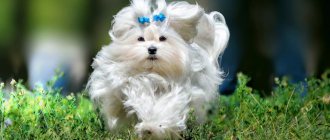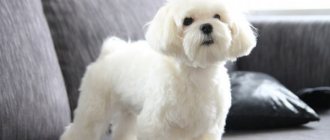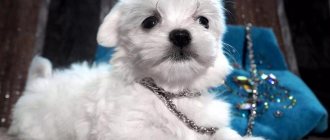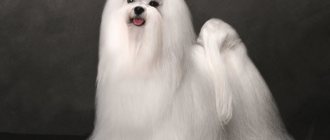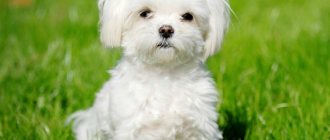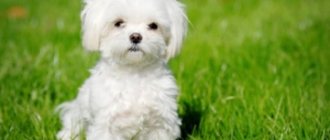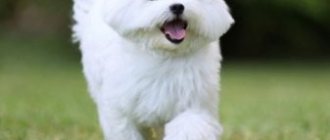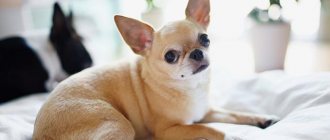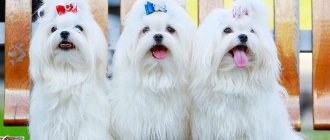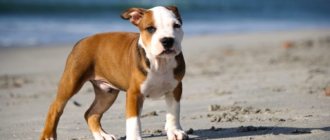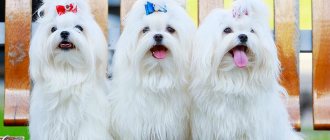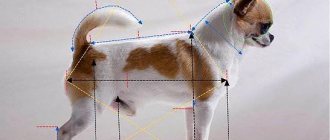More and more people are choosing small and medium-sized dog breeds for keeping them at home. They do not cause big problems in care and such a small pet can always be taken with you.
This type of breed also includes the Maltese (Maltese). Read more about this dog breed in our article.
Description and features
The study of ancient historical chronicles makes it possible to establish that the Maltese breed is one of the oldest.
Archaeologists have found stone images of her, which they say were created in the 7th-8th century BC. The homeland of these charming creatures is Greece, or rather one of its cities, Malta. Hence their name. According to another popular version, lapdogs come from Egypt. Be that as it may, today they are distributed throughout the world.
In the 8th century, receiving a charming white mini-dog as a gift was prestigious and honorable. It was considered to have status, so it was presented as a gift only if the person was highly respected. Many people still associate the Maltese with a comfortable, luxurious life.
One of the most famous admirers of representatives of this breed was the English Queen Victoria. The maximum peak of their breeding occurred in the 30s of the 20th century. World wars had a negative impact on the population of these dogs. In 1945, only a few lapdogs remained in the world. But after just over 20 years, their numbers increased, thanks to amateur breeders.
It cannot be said that the Maltese is a hunter or a watchman. Moreover, it is ineffective to use it for battles. However, the lack of professional orientation does not prevent her from being a good companion, friend and faithful companion for her owner. This dog is purely decorative in nature. His disposition is good-natured and flexible.
Despite their small size, lapdogs surprise with their amazing intelligence. Don't underestimate their strength and intellectual potential! They will definitely surprise the owners. Owning such dogs is worth it for people who are often at home, lead a predominantly sedentary lifestyle and simply love four-legged pets.
The Maltese is a very affectionate and friendly creature, which nature has not endowed with aggression and suspicion. However, if the dog senses danger emanating from strangers near its owner, it will certainly want to protect him. Selflessness is inherent in her.
How to choose a puppy
Due to the high cost of dogs, the Maltese breed is not as common as other decorative dogs. This is a plus - there is less risk of stumbling upon an unscrupulous breeder selling sick or puppies that do not meet breed requirements.
Maltese puppies: photos.
However, scammers are everywhere. Therefore, before buying a Maltese dog you need to:
- check the pedigrees of the producers and the metrics of the Maltese puppy;
- look at the parents (at least the bitch) live;
- examine the Maltese puppies - they should be healthy, playful, not afraid of extraneous, loud sounds;
- Take a dog handler or an experienced breeder with you - they will determine how well the kittens’ exterior meets the standard requirements.
Babies have short fur - it will grow back later. Also, a Maltese puppy may have a wavy (but not curly!) coat - it will straighten out over time.
The Maltese is an elite dog. If the owner plans to engage in breeding, you need to seriously approach the choice of a sire - a male or a female. They pay attention to genetic data, certificates and awards, and breed qualities.
Description
The lapdog is a decorative dog with miniature size and a wonderful character. These creatures have many varieties of breeds, but there is a significant connection between their external characteristics.
The head of the lapdog has a rounded shape, it is small in size and proportional to the body. The frontal part of the head is round in shape. Superciliary ridges are absent.
The muzzle is small. The transition from the frontal part to the nose is visually visible.
Thanks to the wide-open nostrils, lap dogs do not have breathing problems.
The nose and lips have small areas of pigmentation corresponding to the coat color of the breed. The lapdog's mouth is completely closed, lips pressed tightly against each other. According to the breed standard, the bite should be a scissor bite. Sometimes options for a small snack or undershot are allowed. So that no gap is formed. The dental incisors are positioned at an angle of 90° relative to the jaw.
The eyes are round in shape without protrusions, most often brown in color. Pigment color is visible on the eyelashes. For this reason, the dog's gaze seems intelligent. The ears of lapdogs are set high and have a triangular shape. The tips of the ears are slightly rounded. When hanging, they lie close to the muzzle. The outer surface of the ears is covered with medium-length hair.
The neck is set high on the body. The body does not have pronounced muscles. The dog's body is folded in a square, slightly elongated shape. The back is flat and wide enough. The lumbar part protrudes slightly. The muscular croup has a rounded shape with a slight slope. The chest of lapdogs, like large dogs, is very well developed and oval in shape. The belly is tucked up.
The tail is set high on the back of the body, has a ring shape, and is completely covered with long and thick hair. Most often, the tip of the tail of lapdogs is curved behind the back. The front legs are parallel to each other. The thighs are muscular, the joints are dry. The paws are medium in size and oval in shape. There is dark pigmentation on the paw pads.
The hair is soft and pleasant to the touch. In bright light, a dog's coat looks shiny and silky. The color of lapdogs is in most cases white, although there are varieties with black and brown coats.
Quite often, small patches of other colors can be found on the paws and belly.
The weight of adult lapdogs ranges from 3-4 kg. The standard height at the withers is 20-25 cm. The animal's life expectancy is approximately 12-15 years, but with proper care and healthy heredity, lap dogs live 20 years. The intellectual capabilities of miniature dogs do not always meet the requirements of their owners.
These miniature creatures lack guard potential. But when danger arises, lap dogs in a state of passion can not only bark at a stranger, but also bite.
Possible diseases
White Maltese are the owners of truly good health. Provided it receives all the necessary nutrients, adheres to the daily calorie intake, and takes daily walks in the fresh air, the dog will delight its owner for the required twelve to fifteen years. But not everything depends on these factors, and sometimes the animal exhibits genetic diseases.
Dogs of this breed often visit the veterinarian due to eye diseases, inflammation of the skin, and ears. In addition, you should monitor the condition of the cardiovascular and digestive systems. If dietary recommendations are not followed, the animal may develop obesity or food allergies.
The following diseases are typical for Maltese dogs:
- glaucoma;
- retinal atrophy;
- blindness;
- blocking tear streams;
- diastasis;
- pyloric stenosis;
- dermatitis;
- cryptorchidism;
- deafness;
- stroke.
The Maltese's joints are rarely treated due to the animal's miniature size, but in some individuals the kneecap may dislocate. Hydrocephalus leads to stroke.
It is important to monitor the oral health of your little furry. Despite the fact that dogs' teeth are very strong, it is important to prevent the occurrence of caries and tartar, since the treatment of this kind of disease is quite expensive.
Dogs of decorative breeds are more susceptible to cancer than other animals. Blood cancer and pancreatic cancer are common among Maltese dogs. These diseases are typical for bitches from 12 to 15 years old. Cancer cannot be prevented, but if diagnosed early, the chance of recovery doubles or triples.
Mating
Maltese dogs mature and grow physiologically quickly. The first heat in bitches occurs at 6–7 months, less often at 10–12 months.
However, Maltese dogs are untied no earlier than 15 months, or on the third heat. The latter are repeated every six months. But you can’t “force” a dog to get pregnant so often. According to generally accepted rules, the next mating is carried out on the second heat after birth.
Childbirth in Maltese dogs is usually trouble-free. A doctor's intervention is not needed, but the owner's help is required: he accepts the puppies and monitors the condition of the bitch. She gives birth to 2 to 5 puppies.
Hygiene
Timely grooming is a prerequisite for quality animal care. Lap dogs of any breed need to be washed frequently - once every 8-10 days is enough. To wash wool, you need to purchase specialized shampoos that contain various oils, which will allow the fur to remain silky and soft.
After washing, the soap suds must be thoroughly rinsed off, otherwise the animal’s coat will become dull and irritation will occur on the skin. After shampoo, the animal's coat is treated with balm or conditioner, which makes further combing easier.
The lap dog's wool is dried with a towel, after which a hairdryer is used. During drying, it is important to comb the animal's hair in the direction of growth.
We should not forget about timely grooming of the animal, since their fur growth occurs at the maximum pace.
It is not recommended to cut your dog's hair on your own; it is best to contact a professional.
An important part of animal hygiene is timely trimming of nails. Overgrown nail plates will constantly cling to the floor coverings and cause discomfort in the dog. In some cases, the animal may even be injured. The nail trimming procedure must be done once every two weeks. It is best to do this after bath procedures, when the claws become soft.
Dental care should be done daily. Every day the owner needs to check the jaw for plaque and tartar. Teeth brushing is done once, maximum twice a week with a special toothpaste and brush.
Once every two weeks it is necessary to treat the dog’s ears - cut off the overgrown hair and rinse the ear canal, as well as get rid of unpleasant discharge.
A dog's eyes are a very delicate organ, so they require special attention. It is important to constantly inspect and remove mucus that has accumulated there. If your pet has frequent purulent discharge, you should contact your veterinarian. Many new owners confuse painful discharge from the eyes with ordinary tears. The reason for this is the hairs growing near the corners of the eyes, falling on the eyeball and being an irritant.
About dogs: Which dogs don’t shed or smell: 5 breeds that require less cleaning time and from which there are no allergies
Nurseries
When choosing a pet, it is not recommended to trust unverified sources. You should contact dog breeding kennels or reputable kennel clubs. By purchasing a dog in specialized places, the buyer is guaranteed to protect himself from purchasing a mixed breed, genetically diseased offspring, or a litter from an emaciated, sick female. When selling titled puppies, the breeder is required to provide a veterinary passport, the mark of the Russian Canine Federation, and a record of age-appropriate vaccinations. To be more confident, you should contact an independent expert. It is allowed to separate the puppy from its mother after two months. The breeding of lapdogs is practiced in almost all major cities. A list of nurseries and breeders, addresses, photographs and reviews can be found on the Internet.
Wool grooming
It is possible to care for a Maltese at home. But you should prepare for the fact that all your free time will be spent on your dog. This is the main disadvantage of the breed.
The main problem is the fur coat. White wool requires regular washing, combing and trimming.
Grooming depends on the age of the Maltese:
- from 3 to 8 months, Maltese puppies are dressed in “baby fluff”; all they need is daily brushing;
- from 8 to 12 - 15 months, the fur coat is changed to an adult one - so that the hairs are renewed faster, the pet is combed 2-3 times a day, the long grown hair is put into curlers, thereby protecting it from dirt and damage;
- at 12-18 months the coat is completely renewed - it is constantly put into curlers, trimmed, and given the first haircuts.
The Maltese coat has no undercoat, does not shed and is hypoallergenic. But it is problematic to care for. Need to:
- comb the Maltese dog every day to prevent tangles - use several combs with teeth of different lengths and frequencies, massage brushes, antistatic sprays that untangle the hairs;
- cut out tangles if they have formed;
- collect long hair on the head into a tight bun using an elastic band or hairpin so that it does not get into the eyes or cover the muzzle.
Haircuts are a different story. They are done every 2-3 months in a pet salon, trimming regrown hairs. The classic Maltese hairstyle is a long, flowing coat, parted down the back from the neck to the tail. In addition, the hair between the toes and around the anus is trimmed.
For an exhibition career, only a classic haircut is suitable. Dogs that do not participate in competitions can be cut like a puppy - this will make grooming easier.
They also resort to original hairstyles - like a lion or a poodle. The photo of such dogs looks original, but haircuts are not provided for by the Maltese standard.
Upbringing
The characteristics of the breed are such that in the classical sense, training a Maltese is not necessary. However, education, good manners and knowledge of basic commands are necessary.
They begin to work with the animal as soon as the Maltese puppy crosses the threshold of the apartment. The new family member is shown a place, a toilet, given a “tour” of the rooms, and introduced to the household.
Maltese dogs are smart. They understand on the fly what is wanted from them and what behavior is undesirable. The owners note that the dogs go to a diaper or in a basin within 2-3 days, and stop mischievousness after the first reprimand. Although some pets are stubborn and capricious.
Severe punishments are prohibited - a condemning (but not loud!) voice will suffice. And puppies up to 3-4 months are not scolded at all.
The Maltese dog is accustomed to a nickname, commands “Fu”/“No”, “Come to me” at 2-3 months. From 4 to 6 months, the remaining orders from the general training course are introduced - “Lie down”, “Sit”, “Stand”, “Nearby”, etc.
Maltese dogs don't need anything more. But they are taught tricks if they wish. For pets, this is a game and a way to spend time with the owner. They “die” with pleasure, bring newspapers and slippers, dance, etc.
Training
All lap dogs must undergo training and education. Moreover, each owner in this case pursues his own specific goal. Some are preparing their dog for a show, others want to learn to understand the animal and instill in the dog the skills to communicate with people. Still others want to make their dog a source of pride in the eyes of others. The main thing is to find the right approach to the dog so that its education is effective.
Training a lapdog should begin from puppyhood. For completed tasks, the dog is rewarded with treats. The main thing is to choose the right reward, since the little puppy’s body is still developing. The second method of training is imitation. Little puppies, like children, try to follow the actions of adults. Many breeders claim that it is the imitation method that allows them to raise the best and most obedient dog.
The training process must take place at a certain time. This way the dog can determine its daily routine. It is important for the owner himself to determine the time for training - for some it is convenient to train the dog 2 or 3 times a day before feeding or after eating after three hours.
In this case, the second option is best suited, since the dog is already starting to feel a little hungry and will follow commands with great pleasure, expecting a sweet treat.
The owner needs to pay special attention to the animal’s equipment for training. You must have a collar, muzzle and several leashes with you. The treat should be in a special bag so that the puppy can see where the reward is coming from. It is important to give encouragement to the animal only with your right hand.
At first, when training, the animal must be verbally praised, saying that the dog is great, doing everything correctly and well. Lapdogs understand kindness and praise, and accordingly, they will try to please their owner in the future.
Commands should be given in a calm and quiet voice, otherwise the lapdog will take the instruction as an insult and even cry. During training, it is very important to give the animal a short break.
You will learn interesting facts about lap dogs from the following video.
Health
Maltese are generally healthy, but like all breeds they are susceptible to certain diseases.
- Patella luxation in dogs (patella): This is when the knee joint (often the hind leg) becomes dislodged, causing pain.
- Portosystemic liver shunt: This liver disease occurs when an abnormal vessel causes blood to bypass the liver and therefore not be cleared.
- Progressive retinal atrophy (PRA): a degenerative eye disease. PRA blindness is a slow process that results from the loss of photoreceptors in the back of the eye.
- Hypoglycemia: This condition is caused by low blood sugar levels. Some of the signs may include weakness, confusion, unsteady gait and seizures.
- White Dog Shaker Syndrome: This is a condition that primarily affects white dogs. Signs of this condition include tremors throughout the body, poor coordination, and rapid eye movements. Symptoms usually appear when the dog is between six months and three years old and is stressed or overly excited.
- Tracheal Collapse: Some dogs are prone to this condition in which the trachea, which carries air into the lungs, tends to collapse. The most common sign of tracheal collapse is a chronic, dry, harsh cough, which many describe as sounding like a "goose whistle."
- Reverse sneezing: Sometimes confused with tracheal collapse, this is a much less serious condition that lasts only a few minutes. Reverse sneezing usually occurs when your dog is excited or tries to eat or drink too quickly. It can also happen when there is pollen or other irritants in the air. Discharge from the dog's nose falls onto the soft palate, causing it to automatically close over the trachea. Lightly stroke his throat to help him relax.
Characteristics of the Maltese
| Attachment level | High |
| Friendliness | High |
| Suitable for children | Not really |
| Loyalty to other pets | High |
| Exercise needs | Low |
| Playfulness | High |
| Energy level | Average |
| Learning ability | High |
| Intelligence | High |
| Tendency to bark | Average |
| Shedding level | Short |
Origin story
The Maltese dog (Maltese) received its name from the Semitic “malat” - “refuge”, a derivative of the word “melita”. Many islands and seaports were previously called this way.
The breed is also called the Melite Dog, the Ancient Maltese Dog, and the Maltese Bichon.
Presumably, the Maltese breed originated on one of these islands near Dalmatia. Previously, their homeland was called Meleda, today it is Mljet.
However, the exact origin of the dogs is not known. Their ancestors probably lived in the port cities of the Central Mediterranean and exterminated rodents.
While historians argue about the origin of the Maltese, no one doubts their antiquity. The first mention of the breed dates back to the 6th century. BC e. Figurines and images of dogs were found during excavations in Ancient Egypt, Greece, and Rome.
In the 1st century n. e. Maltese dogs came to China along with merchants. And in the Middle Ages - to Europe.
Even in ancient states, Maltese were the favorites of the nobility and monarchs. And from the 23rd century they completely migrated to palaces. The history of the breed marks the peak of popularity in the 16th century. The dogs were the favorites of Philip II, Mary Steward, and Elizabeth I.
In the same 16th century, there was confusion with the name. Until the 3rd century, Meleda was called not only an island off the coast of Dalmatia, but also Malta. Without understanding the origin of the dogs, they were dubbed Maltese or Maltese.
In Russia, they learned about the Maltese in 1812, during the Patriotic War with France. During the retreat, the French left behind several decorative dogs, which they called “French lapdogs.” However, the breed's exterior was lost: the pets were crossed with local dogs.
The first Maltese exhibition was held in Birmingham in 1864. Snow-white angels fascinated dog handlers: they recognized them as a separate Italian breed and developed a standard. And in 1873, an English club for Maltese lovers opened.
In Russia, the breed was introduced in the 20th century. The first representatives were brought from Czechoslovakia. But breeders made mistakes in breeding, and by the 80s. There are no Maltese dogs left that meet the requirements of the standard.
Now the situation is improving. The breed is actively bred in the CIS countries, nurseries and clubs have been founded. However, the Maltese remains one of the rarest and most elite decorative dogs.
Representatives of the stronger half
Elvis Presley - The King of Rock and Roll and Fitzhugh... Elvis, what is he writing?
Robbie Williams - Frank Sinatra of the 21st century
Jacques Rene Chirac – President of France, Prince of Andorra, Mayor of Paris, Prime Minister of France
Feeding
Maltese dogs eat little, but are whimsical in their diet.
A significant disadvantage is that Maltese dogs gain excess weight quickly. Faster than any other decorative breed. Therefore, doggies should not be overfed.
Plus, Maltese dogs are finicky. They are wary of unfamiliar food and beg for tidbits. Pets may refuse a healthy portion of porridge with meat and beg for cookies or cheese. You cannot follow the lead, otherwise problems with digestion and hair will arise.
About dogs: Maltese: description of the dog breed, advice on care and maintenance -
Maltese dogs can be fed natural food or prepared food. The first type of nutrition is standard, consisting of meat, cereals, vegetables and dairy products. However, there are several features:
- the volume of each serving is 50 g per kilogram of weight;
- meat and by-products make up 50%, the remaining 50% is allocated to cereals, vegetables, fruits, dairy products, fertilizing;
- be sure to include vitamin and mineral supplements;
- It is useful to add greens, chicken or quail yolk with olive oil and cottage cheese, 1 tsp. chopped walnuts with honey.
When choosing dry food, take into account the Maltese dog's tendency to gain weight, allergies, gastrointestinal diseases, skin and coat problems. Therefore, they choose grain-free products (holistic class), lines for small breeds with low activity, brands for improving skin and coat.
Ready-made foods suitable for the Maltese lapdog include:
- Acana Heritage Small Breed Grain Free for puppies;
- Guabi Natural for miniature breed puppies;
- Grandorf 4 Meat & Brown Rice Hypoallergenic for adult toy dogs;
- Barking Heads "Tiny Paw's Bad Hair Day" Adult Lamb;
- 1st Choice Dog Adult Toy & Small Breeds Healthy Skin & Coat Lamb & Fish.
Maltese eyes are indicators. They determine whether the food is suitable or not. If they don't eat properly, they water profusely.
Nutrition
Feeding lap dogs of any breed should be timed. Portions should be limited, since with a large amount of food consumed, dogs gain excess weight, and this can lead to various diseases. The most suitable option for feeding a lapdog is balanced food, which contains important vitamins and microelements. The lapdogs themselves prefer food made from natural ingredients.
The first days after purchasing a puppy, it is necessary to feed it the same as the breeder fed it. And after a few weeks you can switch the animal to a different diet. The main thing is to remember to monitor your puppy’s reaction to new foods.
Lap dogs do not have any special preferences in food, for this reason the owner can feed the animal with any food, but it is best to give it super-premium and elite-class dry pads.
An inexperienced dog breeder needs to become familiar with common mistakes when feeding lap dogs of any breed.
- Despite the sweet and sensitive look of a dog asking for a treat, it is forbidden to give it food from the human table. After several treats, it will be impossible to wean the animal from begging.
- Under no circumstances should you give your dog sweets; for them it is real poison.
- Smoked meats should not be present in the diet of lapdogs.
- Feeding the dog must be done according to the established schedule and not deviate even one step from it.
- After a hearty lunch, you should not play with the animal or take it outside. After eating, lap dogs need to rest.
If you strictly follow the presented rules, your small decorative pet will feel great.
Next, it is proposed to familiarize yourself with the intricacies of the process of feeding a lapdog.
- Fractional nutrition for puppies should consist of 5-6 feedings per day, for adults - 2-3 times.
- The feeding process must be done at the same time.
- Puppy portions should be small, maximum 90 g. For an adult, the norm is 120-140 g.
- When choosing a natural diet, the owner should know that 80% of the dog’s daily diet should consist of meat products, the remaining 20% should be vegetables, fruits, dairy products and cereals.
- Many breeders have noticed that lap dogs show a special love for quail eggs. Only you can give them to an animal no more than twice a week, a maximum of 2 pieces.
Pros and cons of the breed
The miniature size of an adult individual, their external characteristics and playful disposition attract the attention of lovers of decorative dogs. However, there is no need to rush into purchasing an animal. The dog's mental abilities and the need for constant physical activity make lapdogs unusual representatives of indoor dogs. But such conditions for keeping an animal are not suitable for every breeder.
Next, it is proposed to familiarize yourself with the advantages and disadvantages of the breed, thanks to which you will be able to make a decision regarding the purchase of an animal. Initially, you should consider the positive aspects.
- Miniature dimensions. Due to its size, the animal easily adapts to the environment of even a small one-room apartment. Even a small living space can become a huge springboard for a dog to explore its surroundings.
- Development abilities. With the right approach to the animal, the lapdog will perceive any new information with great interest, follow commands, and solve complex problems.
- No shedding. Lapdogs do not suffer from seasonal hair loss. For this reason, the owner will not have to carry out general cleaning and wash clothes every day before leaving the house.
- Lack of aggression. These dogs have a very kind and sweet character. It is extremely difficult to piss them off.
- Love for children. Lapdogs become very attached not only to their owner, but also to his children.
- Health. An important indicator of a pet’s strong immunity is good care and heredity.
- Hypoallergenic. No matter what anyone says, there has not been a single case of an allergic reaction in humans to lapdog fur recorded in the world.
Along with the positive aspects of keeping and raising lapdogs, there is a small list of disadvantages that affect the decision to purchase a dog.
- Special care for the coat. The hair of lapdogs is their property. Accordingly, you will have to monitor the appearance of the animal extremely scrupulously.
- Activity of lap dogs. Dogs need daily walks, not 2 times a day, but preferably 4 or 5 times a day.
- Loud voice. Once a lap dog starts barking, it will be very difficult to stop it. And a long and loud bark will be very annoying.
- Picky eating habits. These dogs do not always eat what their owner gives them. Sometimes they show a desire to taste another dish.
- Sociable character. It is very important that there is a person next to the dog throughout the day. Lapdogs love human communication and cannot stand loneliness.
- Lack of attention. The lapdogs believe that they are one of the main members of the family. Therefore, they require special interest from the owner. If there is a lack of attention, the animal's character may deteriorate.
- Health. Unfortunately, lap dogs are prone to many diseases that are inherited.
Nicknames
A well-chosen dog name can reflect its character and habits. Remember, this is a dog of aristocratic origin, which means its nickname must be appropriate.
A nickname is a kind of command that the dog will hear throughout its life. It should be easy to pronounce, correspond to the gender of the pet and be harmonious.
You should not call a Maltese by a human name, much less by the name of a previously deceased pet. Comic nicknames are also not suitable, because they can provoke an embarrassing situation when in public. Believe me, by looking into the dog’s button eyes you will immediately understand what nickname it needs.
The most common nicknames for boys:
- Austin.
- Monty.
- Vander.
- Cake.
- Roland.
Popular names for girls:
- Charlie.
- Lucy.
- Blondie.
- Emmy.
- Zhully
Pros and cons of character
Malteses are the embodiment of love and tenderness. The highest happiness for them is to be close to their owner. And it doesn’t matter what a person is doing: playing, resting, working or cooking. Maltese dogs happily participate in any activity.
The Maltese not only has an angelic appearance, but also an angelic character. They are not prone to irritability, mood swings or grumpiness like other decorative breeds. Dogs pick up on people's moods and adapt to them.
Some Maltese dogs are moody. But this is the result of poor upbringing: overprotection and indulgence in whims.
Reviews from owners say that dogs catch thoughts. They understand when the owner is upset and predict what he is going to do.
Maltese love all family members and do not single out any one person. The disadvantages of the Maltese dog are that they are attached to people and cannot stand being alone. Sometimes this trait is developed to the point of neurosis: as soon as the pets are left alone, they begin to howl, whine and destroy the apartment. You cannot leave your pets alone for more than an hour.
Maltese dogs are playful and active. They delight in their “attacks of energy”: a couple of times a day, the dogs suddenly start rushing around or running in circles.
At the same time, Maltese dogs are not hardy. After wandering around for 5-15 minutes, they calm down and go to lie down on their favorite ottoman.
The Maltese has a weak nervous system. They are handled with care. Irritability and rudeness are unacceptable.
Application
From the first day of its existence until today, Maltese dogs are exclusively companions. They were created to love and be loved.
At the same time, the Maltese breed demonstrates good watchdog and security qualities. Despite its tiny size, in case of danger the dog fiercely defends itself and its owner. True, not all pets have this trait.
It is worth considering that a small Maltese dog will not cope with protection. She can only bark or claw at an ill-wisher.
Moreover, pets sound the alarm for any reason. An unpleasant-smelling man passed nearby, the doorbell rang, they were shouting behind the wall, someone was climbing the stairs - and the Maltese immediately gave a voice. The dog should be weaned from excessive barking, otherwise complaints and complaints from neighbors will flow in a torrent.
A decorative dog is best suited for housewives, married couples, elderly people and all those who can and are willing to devote almost all their time to their pets.
Content Rules
Keeping a lap dog is a rather complicated process, but if you set your priorities correctly, then no problems will arise. It is important to remember that lap dogs of any breed should live in apartments or comfortable cottages. A private home is not the best option for decorative dogs. This is due to their miniature size, which makes the animals defenseless even against yard cats. Also, the lapdog has no undercoat. If an animal jumps out of the house into the street, then there is a high probability that it will freeze, and the fur itself will turn into one large tangle.
Dog owners living in cottages are allowed to let the animal out unaccompanied by the owner for a short period of time. The main thing is to make sure in advance that there are no loopholes in the fence and the dog cannot escape.
About dogs: The strongest, smartest, dangerous dog breeds. Cane Corso, Dogo Argentino, Doberman, pit bull, bullmastiff, Rottweiler, Labrador, boxer, German shepherd, Alabai: which dog is better, smarter, stronger, more dangerous: comparison, difference, which one is better to have
For a comfortable stay, a lapdog requires a separate corner and a small personal territory.
- In a separate room, it is enough to allocate a small space where you can lay a bed or install a decorative house. The kitchen will need to provide special utensils for food and water.
- The dog will need toys for personal leisure.
- Lapses require an individual collar and leash. At the same time, it is important to make a special tag on the collar with the owner’s information in case the dog runs away.
- To properly care for your dog, you will need to acquire grooming tools, such as combs, brushes, and nail clippers.
- If the owner decides that the animal will go to the toilet at home, he should stock up on several packs of disposable diapers and a litter tray. At first, the puppy will do his “business” in the wrong place, but gradually he will get used to his toilet.
- In autumn and spring, even an adult dog must wear special clothing. The animal warms itself in it and does not stain its fur. For the winter period, your lapdog will need to purchase boots.
Breed standard
The Maltese dog is a small indoor dog with a pleasant appearance. No operational tests were carried out to test its strength and endurance. The dog's peculiarity is its proud, beautiful posture. She has a slightly elongated back and a straight spine.
The dog's ribs should not protrude. Its sternum is quite narrow, and its neck is of medium length. The symmetrically spaced legs are equipped with strong, lean muscles and strong bones. The peculiarity of the breed is the fingers collected in a dense ball. They have soft pads.
The animal weighs from 2.5 to 4 kg. The overweight is extremely undesirable. His height is 21-26 cm. The dimensions of the Maltese are compact, it can easily be placed in a spacious bag or basket. The Maltese dog in the photo looks very elegant. She moves freely, without sudden movements, as if floating through the air.
The tail, thickened at the base, is set high. According to the standard, it should hang evenly in the center of the dog’s back, but a slight deviation to the right or left is allowed. On a medium-sized head, a flat forehead is visible. The Maltese's muzzle is slightly flattened and well defined.
In the center of it is a large dark nose. The lips are visible and have a dark tint. There is no saliva dripping from the dog's mouth because it has dry gums. Liquid in her mouth is released only when she eats. The dog's ears are small, neat, hanging down. The eyes are large, with a dark iris, reminiscent of large black buttons.
This animal has very dense fur. It is thick and delicate, reminiscent of silk to the touch. According to the standard, it should shine. The lapdog's coat should not be curly. It is important that it is straight. Now about the color of the fur.
Dark markings on a dog's body are extremely undesirable. Its fur can be pure white or beige (ivory). If a Maltese has brown or black markings on its body, it will be disqualified from the competition.
Experts highlight the following disadvantages of the breed:
- Not a scissor bite.
- Curved skull.
- Uneven nasal dorsum.
- Overweight or underweight.
- Dark wool.
- Short tail.
- Strabismus.
Character
Many people consider the lapdog an ideal pet. Few people know, but despite its pampered appearance and small size, this is a very brave creature that is not afraid of almost anything. However, like most four-legged pets, the Maltese can be frightened by loud noises, swearing by its owners, physical violence, etc.
The dog is not devoid of sociable inclinations. She accompanies her beloved owner almost everywhere. I don't tolerate loneliness well. That is why experts strongly advise against having such dogs for those who plan to be away from home for a long time.
They become attached to people very quickly, harboring the most tender and reverent feelings for them. Most often, lonely old people get such pets. Little kind dogs help them brighten up their lives and have fun.
They will be happy to accompany the owner on a walk, but not for a long one. They tend to get tired quickly, so they don’t like regular exercise. Moreover, systematic sports activities can lead to serious health problems in the animal. Be sure to keep this in mind.
Advice! If you are a lover of outdoor activities, then a lapdog is clearly not suitable for you as a companion. She gets tired quickly and needs a long rest. It is better to run at the stadium and go to nature with a Drahthaar, Labrador or Beagle.
These charming creatures love people's attention. That is why they feel comfortable at animal shows. This pet is able to feel proud when it notices the glances of interested people. It is extremely important for him to gain the respect and respect of the majority of the audience. Very photogenic, artistic and funny.
Violent expression of emotions, impulsiveness, a tendency to suspicion and aggression - this is definitely not the case with the Maltese. She is a calm, balanced dog who loves not only noisy companies, but also solitude. Prone to sudden mood swings.
If she is upset or offended by something, she will quietly retire, moving away from the irritant. But, most often, she is playful, energetic and cheerful. He loves to be the center of attention of cheerful guests, delight them with his cuteness and receive verbal approval. Without such “events,” he may withdraw into himself and sleep all day, gaining strength.
It is important for a Maltese, like any other dog, to regularly receive new emotions. We recommend taking her for a walk by the river, allowing her to independently explore objects in the immediate radius, throwing her a ball and asking her to bring it. By the way, this dog loves to play. Winning her affection is easier than it seems. It is enough to invite her to a fun game several times.
Many people call these charming dogs “intelligent.” They are moderately proud, because they know that they are beautiful and loved by everyone. Therefore, they never impose themselves and do not humiliate themselves by begging. They can be seriously offended by the lack of attention.
They are affectionate with children only if they do not offend them. Noisy children are avoided. They are not prone to conflict behavior, they strive to be friends with their owner’s other animals, but if they are aggressive, they will avoid their company.
Socialization
The main characteristic of the breed is the absence of anger. The Maltese is equally good with adults, children and pets.
This does not mean that the Maltese loves everyone. The most important thing for a dog is family. She perceives strangers and guests warily, with interest, but without aggression. The pet only allows family friends to play with him.
Dogs love children immensely and will never hurt them. You need to worry not about the kids, but about the Maltese - the latter often suffers at the hands of restless dogs.
Families with children under 10 years old are not recommended to have animals. Delicate and fragile Maltese dogs must be handled with care. Extremely careful. Even just by squeezing or dropping the dog, the baby will injure him.
Maltese dogs live in perfect harmony with other pets. Whether it’s a St. Bernard, a cat, a hamster or a parrot, the dog is non-confrontational and is friends with everyone.
Exterior
The breed standard of the Fédération Cynologique Internationale (FCI) classifies the Maltese as a group of toy dogs, a subgroup of the Bichon and related breeds. In addition to the Maltese, this also includes Bolognese and Bichon Frize.
Photo of an adult Maltese dog.
Maltese dogs look charming, both in person and in photographs. These are miniature dogs with a snow-white coat that flows down the sides, black beady eyes and a charcoal nose. They have smooth, refined movements and the manners of aristocrats.
The table provides a detailed description of the breed.
| Parameter | Breed standard |
| Height | 21-25 cm males, 20-23 cm females. |
| Weight | 3-4 kg. |
| Constitution | Developed, dry, without roughness. |
| Frame | Stretched out, with a long straight back and a short arched loin. The neck is of moderate length and holds the head elegantly. The chest is voluminous, long, in circumference equal to 2/3 of the dog’s height. The stomach is slightly retracted. |
| Head | The length reaches more than half the height at the withers. Proportional, wide, ovoid, with a convex crown and nape. The forehead is divided in the middle by a hollow. |
| Ears | They stand high, hanging, if the dog is alert, they rise. In the shape of a triangle with round ends. Covered with long hair, which smoothly connects with the fur coat at the withers. |
| Eyes | Large, round in shape, set low and moderately deep. The color is dark brown, the edging is black. |
| Nose | Small, black. |
| Lips | Dry, thin, black mucous. The upper lip hangs over the lower lip. |
| Bite | Scissor-shaped. |
| Limbs | Straight, muscular, parallel when viewed from the rear or front. Stand clearly under the body, elbows pressed to the chest. |
| Paws | Small, collected in a round lump. Richly covered with wool. The pads and claws are strong and black. |
| Tail | Stands at the height of the back, thrown back and pressed to the body on the left or right. Equal to 60% of the dog's height, trimmed with straight, flowing hair. |
| Wool | Straight, long, reaches 22 cm, spreads along the ground. There is no undercoat. A mantle flows down the sides. The hairs on the head are the longest, blending in with the hair on the ears and face. |
| Color | White, less often - ivory. |
There are mini (toy) representatives weighing up to 2 kg. But they are not recognized by FCI, AKC and RKF.
